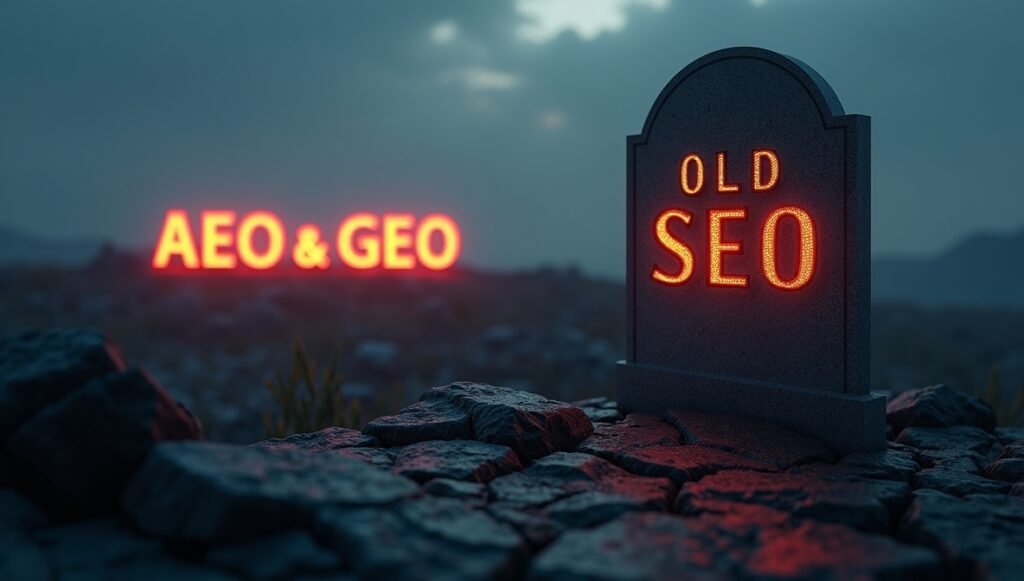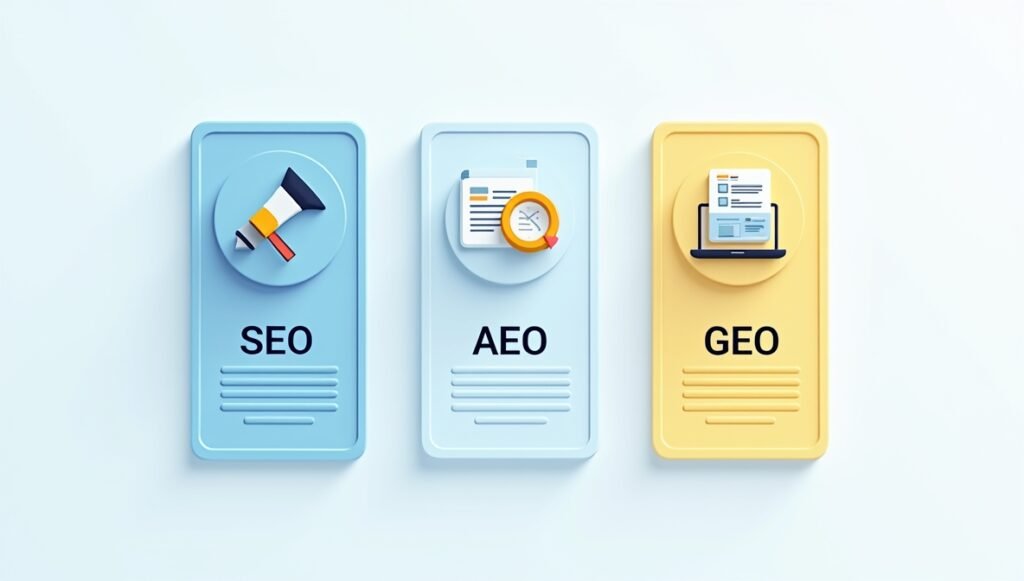Discover why SEO isn’t dead, what AEO and GEO mean, and how to adapt your strategy for the AI-first search era.

Why People Think SEO is Dead
For years, Search Engine Optimization (SEO) has been the key to getting traffic from Google. But with AI chatbots like ChatGPT, Google’s Search Generative Experience (SGE), and voice assistants, the search world has changed.
The question “Is SEO dead in 2025?” is everywhere. The truth? SEO isn’t dead — it’s evolving into new forms like AEO (Answer Engine Optimization) and GEO (Generative Engine Optimization).
In this article, we’ll explore:
- Why SEO is changing but not disappearing
- What AEO and GEO mean for your website
- How to adapt your strategy for the future of SEO

Is SEO Dead? The Truth in 2025
SEO is not dead, but traditional SEO is no longer enough.
Why people think SEO is dying:
- Zero-Click Searches: Google shows direct answers in featured snippets and AI overviews.
- AI Chatbots: People ask AI tools instead of searching on Google.
- Generative Search: Google SGE and Bing Chat create answers without users visiting your site.
Reality: Businesses that adapt to AEO and GEO can still dominate search traffic — but the strategy must change.
What is AEO (Answer Engine Optimization)?
AEO is the process of optimizing your content so that AI tools and voice assistants use it as their direct answer. Instead of competing for a Google ranking, you compete to be the response in Alexa, Siri, ChatGPT, or Google Assistant.
AEO Optimization Tips:
- Target question-based keywords (“What is AEO?” “How to optimize for voice search?”).
- Write clear, concise answers within 30 words.
- Use FAQ schema markup.
- Include conversational language for voice search.
Example:
Q: Is SEO dead in 2025?
A: No. SEO is evolving into AEO and GEO to adapt to AI-first search environments.

What is GEO (Generative Engine Optimization)?
GEO focuses on getting your content cited by AI-driven generative search engines like Google SGE, Bing Chat, and Perplexity AI. Instead of being the answer, you’re the source AI trusts.
GEO Optimization Tips:
- Create long-form, detailed content (1500+ words).
- Show E-E-A-T signals (experience, expertise, authoritativeness, trustworthiness).
- Use data, research, and statistics to make your content credible.
- Update posts regularly to maintain freshness.
Example: When someone searches “Best SEO strategies in 2025” on Google SGE, it might pull a paragraph from your blog with a link to your site.

SEO vs AEO vs GEO – What’s the Difference?
| Feature | SEO | AEO | GEO |
|---|---|---|---|
| Goal | Rank in search engines | Be the answer | Be the source |
| Best For | Organic Google traffic | AI assistants & voice search | Generative AI summaries |
| Content Type | Keyword-optimized articles | Short, direct answers | In-depth, research-based content |

Why AEO & GEO are the Future of SEO
Voice search usage: Over 50% of searches in 2025 are voice-based.
AI as a gateway: More people now ask AI first, Google second.
Zero-click dominance: Google SGE keeps users on search results without clicking websites.
If you want visibility, you need to:
- Answer questions directly for AEO
- Provide deep, trusted content for GEO
How to Optimize for AEO in 2025
- Find Questions Your Audience Asks – Use tools like AnswerThePublic or AlsoAsked.
- Create Q&A Sections – Write blog posts with clear headings like “What is GEO?”
- Add FAQ Schema – Help AI understand your content structure.
- Optimize for Voice Search – Keep sentences short and easy to read aloud.
How to Optimize for GEO in 2025
- Publish Long-Form Content – 1,500–3,000 words with strong topic coverage.
- Demonstrate Expertise – Add author bios, case studies, and client results.
- Use Data & Statistics – AI trusts factual, verifiable content.
- Update Content Frequently – Freshness helps with AI credibility.
Example Future SEO Strategy (2025)
Step 1: Create a pillar article like “The Future of SEO: AEO & GEO Explained.”
Step 2: Break it into smaller Q&A blog posts for AEO visibility.
Step 3: Add in-depth research, statistics, and case studies to earn GEO citations.
Step 4: Refresh content every 3–6 months.
Final Verdict – Is SEO Dead?
No. SEO is not dead in 2025 — but old-school SEO is fading. The future belongs to those who optimize for AEO and GEO, ensuring they are both the answer and the trusted source in AI-driven search.

Pro Tip: Start by updating your existing content with short, clear answers (AEO) and deeper, research-backed sections (GEO). This small change can have a big impact on how AI and search engines use your content.


Great post 📯